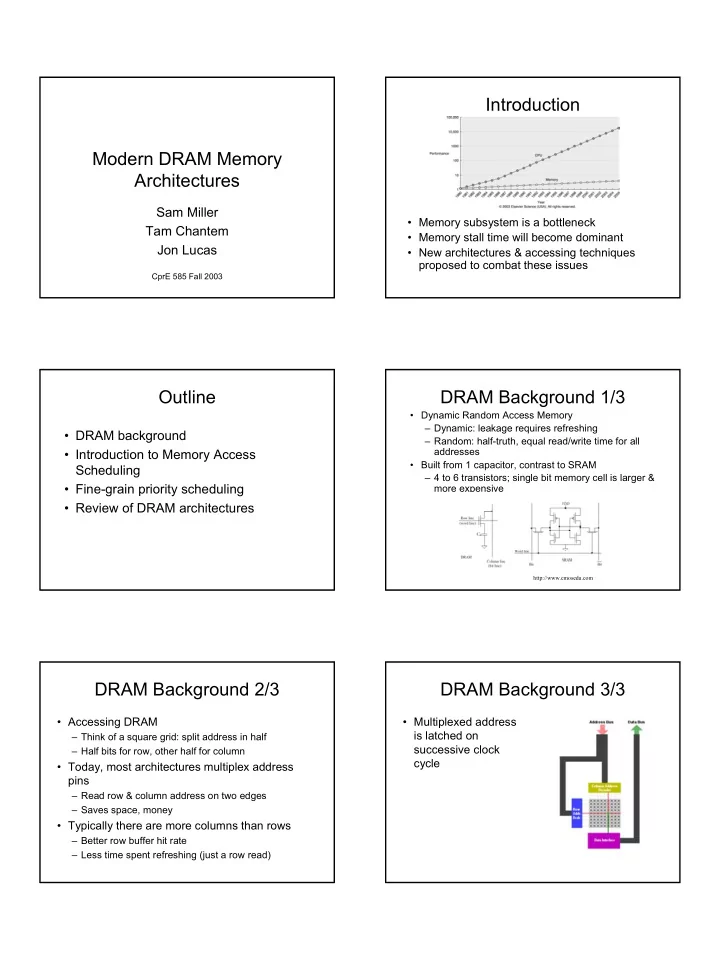

Introduction Modern DRAM Memory Architectures Sam Miller • Memory subsystem is a bottleneck Tam Chantem • Memory stall time will become dominant Jon Lucas • New architectures & accessing techniques proposed to combat these issues CprE 585 Fall 2003 Outline DRAM Background 1/3 • Dynamic Random Access Memory – Dynamic: leakage requires refreshing • DRAM background – Random: half-truth, equal read/write time for all addresses • Introduction to Memory Access • Built from 1 capacitor, contrast to SRAM Scheduling – 4 to 6 transistors; single bit memory cell is larger & • Fine-grain priority scheduling more expensive • Review of DRAM architectures http://www.cmosedu.com DRAM Background 2/3 DRAM Background 3/3 • Accessing DRAM • Multiplexed address is latched on – Think of a square grid: split address in half successive clock – Half bits for row, other half for column cycle • Today, most architectures multiplex address pins – Read row & column address on two edges – Saves space, money • Typically there are more columns than rows – Better row buffer hit rate – Less time spent refreshing (just a row read) 1
3-D DRAM Representation DRAM Operations • Precharge – Desired row is read into row buffer on a miss • Row Access – Bank is already precharged • Column Access – Desired column can be accessed by row buffer S. Rixner et al. Memory Access Scheduling. ISCA 2000. Memory Access Scheduling 1/3 Memory Access Scheduling 2/3 • Similar to out-of-order execution • Scheduler determines which set of pending references can best utilize the available bandwidth • Simplest policy is “in-order” • Another policy is “column first” – Reduces access latency to valid rows S. Rixner et al. Memory Access Scheduling. ISCA 2000. Memory Access Scheduling 3/3 Fine-grain Priority Scheduling 1/5 • Goal: workload independent, optimal • “first-ready” policy performance on multi-channel memory – Latency for accessing systems other banks can be masked • On the highest level cache miss, DRAM is • Improves bandwidth issued a “cache line fill request” by 25% over in-order – Typically, more data is fetched than needed policy – But it may be needed in the future • For a performance increase, divide S. Rixner et al. Memory Access Scheduling. ISCA 2000. requests into sub-blocks with priority tags 2
Fine-grain Priority Scheduling 2/5 Fine-grain Priority Scheduling 3/5 • Split memory requests into sub-blocks • Sub-block size can be no less than – Critical sub-blocks returned earlier than non-critical minimum DRAM request length • 16 bytes is smallest size for DRDRAM • Note: memory misses on other sub-blocks of the SAME cache block may happen – Priority information is updated dynamically in this case by the Miss Status Handling Register (MSHR) Z. Zhang, Z. Zhu, and X. Zhang. Fine-grain priority scheduling on multi-channel memory systems. HPCA 2002. Fine-grain Priority Scheduling 4/5 Fine-grain Priority Scheduling 5/5 • Complexity issues • Compare to gang scheduling – Cache block size used as burst size – Support multiple outstanding, out-of-order – Memory channels grouped together memory requests – Stalled instructions resumed when whole cache block – Data returned to processor in sub-block, not is returned cache-block • Compare to burst scheduling – Memory controller must be able to order – Each cache miss results in multiple DRAM requests DRAM operations from multiple outstanding – Each request is confined to one memory channel requests Contemporary DRAM Architectures 1/5 Contemporary DRAM Architectures 2/5 • Many new DRAM architectures have been • Fast Page Mode (FPM) introduced to improve memory sub-system – Multiple columns in row buffer can be accessed very quickly performance • Extended Data Out (EDO) • Goals – Implements latch between row buffer and output pins – Improved bandwidth – Row buffer can be changed sooner – Reduced latency • Synchronous DRAM (SDRAM) – Clocked interface to processor – Multiple bytes transferred per request 3
Contemporary DRAM Architectures Contemporary DRAM Architectures 3/5 4/5 • Enhanced Synchronous DRAM (ESDRAM) – Adds SRAM row-caches to row buffer • Rambus DRAM (RDRAM) – Bus is much faster (>300MHz) – Transfers data at both clock edges • Direct RAMBUS DRAM (DRDRAM) – Faster bus than Rambus (>400MHz) – Bus is partitioned into different components • 2 bytes for data, 1 byte for address & commands V. Cuppu, B. Jacob, B. Davis, and T. Mudge. A performance comparison of contemporary DRAM architectures. ISCA 1999. Contemporary DRAM Architectures 5/5 V. Cuppu, B. Jacob, B. Davis, and T. Mudge. A performance comparison of contemporary DRAM architectures. ISCA 1999. 4
Recommend
More recommend